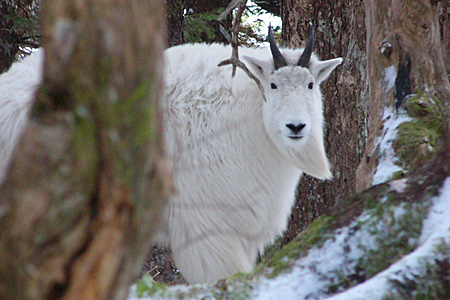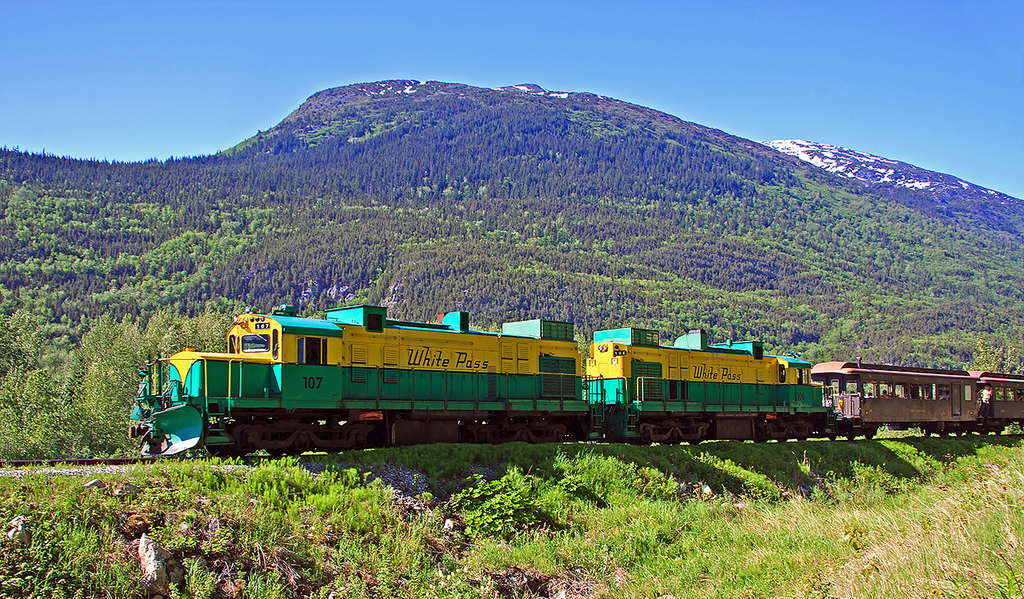
An Alaska mountain goat. (Alaska Department of Fish and Game)
Wildlife habitat studies likely to influence Haines heliskiing and Skagway helicopter tourism will be ready for public release in a few weeks.
Alaska Fish and Game biologists who have been studying mountain goat and brown bear habitat in the Upper Lynn Canal will present their findings to Haines residents in early September.
Anthony Crupi is the bear researcher. He has conducted aerial surveys each spring starting in 2015. He looks for brown bear dens among the mountain peaks of the Chilkat Valley.
“It’s really interesting, surveying for dens from the air,” Crupi said. “So you end up with a search image and in that image you find muddy paw prints and then you track those muddy paw prints back and it’s not too far that you’ll find where the bear has excavated in the soil. And as they emerge from their den they make a track from where that den actually was.”
Crupi has discovered more than 80 dens in the Chilkat Valley. Using those locations, he’s able to draw conclusions about what spots bears are likely to choose for dens.
“A couple of the important things that have come out of it are there are particular slopes and elevations that brown bears select,” Crupi said. “There’s also an amount of vegetation that they associate with their den sites. Those are some of the key factors that brown bears are selecting.”
State biologists are also working on an extensive mountain goat habitat study.
Lead researcher Kevin White has tracked about 70 Upper Lynn Canal mountain goats using GPS radio collars. Like Crupi, he’s using that data to predict what areas mountain goats are likely to use as habitat.
White’s work is aimed at informing heliskiing decisions in Haines and helicopter tourism management in Skagway.
“So that product will provide a data-rich resource for land use decision-makers to decide various areas for land management activities, including helicopter skiing,” White said.
These pending wildlife studies played a role last year in the work of a Haines heliski map committee. The committee was tasked with reviewing two heliski companies’ requests for ski boundary changes. The committee met many times and often had questions about how changing boundaries could impact wildlife.
“You know, there’d be a lot of questions to us like ‘OK, how is this going to affect mountain goats or brown bear denning habitat?'” White recounted. “And we were always a little bit hamstrung in our ability to really provide good information because we hadn’t completed our analyses yet.”
Ultimately, the Haines Assembly postponed heliski map changes to this summer. The group decided to put it off because the mountain goat and bear studies were not complete.
White has been working on the mountain goat project since 2010. He plans to continue the research for at least another three years. But he says there’s enough data to present the results so far and give land managers better information to work with.
White and Crupi will share their findings at two meetings in Haines. The first is a town hall on Sept. 10 at 6 p.m. in the Chilkat Center. That will be a broad overview. The second is a joint meeting of the assembly and two advisory committees that have worked on heliskiing issues. That gathering is Sept. 11 at 6 p.m. White says the conversation there will get more into how the research can be utilized in land management decisions.








